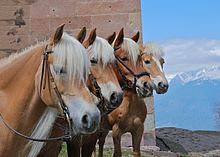Haflinger
![]()
This article is about the horse breed. For the vehicle, see Steyr-Puch Haflinger.
The Haflinger is a mountain horse, which today is primarily used as a robust leisure horse for riding. Officially, the Haflinger belongs to the pony breeds or small horse breeds. The first cloned horse, Prometea, is from this breed.
Table of Contents
· 1 Exterior
o 1.1 Color
o 1.2 Head and physique
· 2 Interior
· 3 Breeding history
o 3.1 Until the end of the First World War
o 3.2 Haflinger breeding in Italy, especially South Tyrol: Aveligneser
§ 3.2.1 Origin of the name
o 3.3 Haflinger breeding in Austria, especially North Tyrol
o 3.4 Haflinger breeding in Germany
o 3.5 Other countries and the World Haflinger Federation
o 3.6 Arabian crosses
o 3.7 Bloodlines
§ 3.7.1 The A-line
§ 3.7.2 The B-line
§ 3.7.3 The M-line
§ 3.7.4 The N-line
§ 3.7.5 The German H-line
§ 3.7.6 The S-line
§ 3.7.7 The ST line
§ 3.7.8 The W-Line
· 4 Use
o 4.1 Sumpter and working horses
o 4.2 Recreational area
o 4.3 Sports
o 4.4 Extraction of foodstuffs
o 4.5 Show
· 5 Miscellaneous
· 6 See also
· 7 Literature
· 8 Web links
· 9 Individual references
Background information on horse evaluation and breeding can be found at: Exterior, Interior and Horse Breeding.
Exterior
Color
While in the beginning there were also browns and blacks, today there is only the chestnut color in combination with the gene flaxen, so-called light foxes. The chestnut color occurs in all variations from cabbage chestnut to light chestnut. However, the cabbage fox colour is rare. Stitch hair or "noble spots" are undesirable and can lead to exclusion from breeding. The longhair varies from flaxen to white, colour impurities are undesirable and can lead to exclusion from the breed.
Often the belly and the inside of the legs are lightened by the gene Pangaré and a flour mouth appears. Head markings from flake to blaze are allowed and desired, but not required. More pronounced markings, such as a lantern, are undesirable and may result in exclusion from breeding. Leg markings are undesirable, but a single leg marking up to half a rail is not judged negatively, while several and larger leg markings can lead to point deductions up to exclusion.
Especially light Haflingers are often confused with Palominos. However, the cream gene does not occur in this breed.
Head and physique
Haflingers have an absolutely and relatively small and short, as well as noble and dry head with a broad and long forehead. The eyes are large, the nostrils wide and the ears small and mobile.
While the foundation stallion Folie was 150 cm high and his sons used for breeding had a withers height between 139 and 146 cm, the average Haflinger was smaller. From 1925 to 1980, the height at withers averaged about 137 cm in all studies. In the meantime, it has been increased to 140 to 155 cm in the World Haflinger Federation through targeted breeding selection. In the German Equestrian Federation, Haflingers are allowed to be 138 to 148 cm tall.
Breeding objective is a well muscled but slender neck without underneck, a long back with good girth depth and a strong loin, legs with dry joints and hard hooves, strongly tied. Sometimes a weak hock with strong limb angulation occurs as a fault.

Head
Interior
Haflingers were mountain horses bred on high mountain pastures. Due to their origin from small mountain farms, selection took place in favour of frugality, so that Haflingers are very light-fed. They were originally considered late-maturing, as their development was delayed by scarce feeding in winter, and mares were therefore covered for the first time when they were four years old. Now they are usually mated at three years of age. Compared to other breeds, Haflingers have a particularly long breeding life: stallions and mares that are still used for breeding at the age of twenty-five are not uncommon. They also have a very high fertility.
If they are treated appropriately, Haflingers are very willing to perform, good-natured and have strong nerves. They are also sure-footed and versatile.

Haflinger in South Tyrol
Search within the encyclopedia